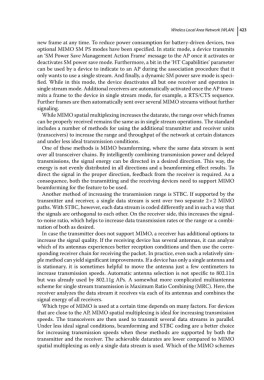Page 437 - From GMS to LTE
P. 437
Wireless Local Area Network (WLAN) 423
new frame at any time. To reduce power consumption for battery‐driven devices, two
optional MIMO SM PS modes have been specified. In static mode, a device transmits
an ‘SM Power Save Management Action Frame’ message to the AP once it activates or
deactivates SM power save mode. Furthermore, a bit in the ‘HT Capabilities’ parameter
can be used by a device to indicate to an AP during the association procedure that it
only wants to use a single stream. And finally, a dynamic SM power save mode is speci-
fied. While in this mode, the device deactivates all but one receiver and operates in
single stream mode. Additional receivers are automatically activated once the AP trans-
mits a frame to the device in single stream mode, for example, a RTS/CTS sequence.
Further frames are then automatically sent over several MIMO streams without further
signaling.
While MIMO spatial multiplexing increases the datarate, the range over which frames
can be properly received remains the same as in single stream operations. The standard
includes a number of methods for using the additional transmitter and receiver units
(transceivers) to increase the range and throughput of the network at certain distances
and under less ideal transmission conditions.
One of these methods is MIMO beamforming, where the same data stream is sent
over all transceiver chains. By intelligently combining transmission power and delayed
transmissions, the signal energy can be directed in a desired direction. This way, the
energy is not evenly distributed in all directions and a beamforming effect results. To
direct the signal in the proper direction, feedback from the receiver is required. As a
consequence, both the transmitting and the receiving devices need to support MIMO
beamforming for the feature to be used.
Another method of increasing the transmission range is STBC. If supported by the
transmitter and receiver, a single data stream is sent over two separate 2 × 2 MIMO
paths. With STBC, however, each data stream is coded differently and in such a way that
the signals are orthogonal to each other. On the receiver side, this increases the signal‐
to‐noise ratio, which helps to increase data transmission rates or the range or a combi-
nation of both as desired.
In case the transmitter does not support MIMO, a receiver has additional options to
increase the signal quality. If the receiving device has several antennas, it can analyze
which of its antennas experiences better reception conditions and then use the corre-
sponding receiver chain for receiving the packet. In practice, even such a relatively sim-
ple method can yield significant improvements. If a device has only a single antenna and
is stationary, it is sometimes helpful to move the antenna just a few centimeters to
increase transmission speeds. Automatic antenna selection is not specific to 802.11n
but was already used by 802.11g APs. A somewhat more complicated multiantenna
scheme for single stream transmission is Maximum Ratio Combining (MRC). Here, the
receiver analyzes the data stream it receives via each of its antennas and combines the
signal energy of all receivers.
Which type of MIMO is used at a certain time depends on many factors. For devices
that are close to the AP, MIMO spatial multiplexing is ideal for increasing transmission
speeds. The transceivers are then used to transmit several data streams in parallel.
Under less ideal signal conditions, beamforming and STBC coding are a better choice
for increasing transmission speeds when these methods are supported by both the
transmitter and the receiver. The achievable datarates are lower compared to MIMO
spatial multiplexing as only a single data stream is used. Which of the MIMO schemes

